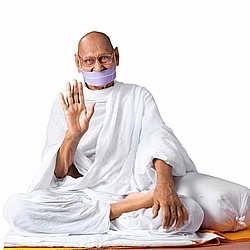
Acharya Mahapragya Blog
The following post is a translated excerpt from Acharya Shree’s book kaise soche (How to think)
The famous philosopher, Descartes proclaimed - I think and therefore I am. That is, the proof of my existence is that I think.
If I had to say this, I would say, “I am, and since I am a being with a developed brain, I also think.”
Thinking is not a characteristic of the brain. It is an expression. Our existence and consciousness is beyond thinking. Thinking is a spark of the light the consciousness is. When we’re not thinking - the light is in its full form.
Through meditation we want to reach that state, where thinking finishes, and witnessing becomes possible. Where there is witnessing, there, thinking is not needed. A fruit is placed in our palm. Whatever it is, we can see it. We don’t need to think about it. Wherever there is seeing, thinking is not present and where there is thinking, seeing is not present.
We experience three states - waking, seeing, and thinking. A man asked “did your servant do that task? The man replied - I don’t know. I’ll tell you after I know.” In this situation, there is no need to think.
Consider another instance. Someone asks “Do you have this thing in your house?” In such a situation, the most usual reply would be “I’ll see and let you know.”
In one instance, the reply is “I’ll find out and tell you” and in another instance, the reply is “I’ll see and let you know.” Where there is knowing and seeing, there thinking is not needed. When one is not in a state of seeing or knowing, one is in the state of thinking.
Thinking is needed when we don’t know clearly about a subject - when nothing absolute can be said about it.
Thinking is a component of our consciousness. Therefore, it is just a spark. However, it is not the full form of consciousness. When one achieves the state of witness consiousness, thinking ends.
The goal of meditation is to reach the state of witness consciousness. When witnessing is present, then thoughts disappear and seamless knowledge surfaces above. Till the time when one is bound to the body and his imperceptible consciousness doesn’t awaken, thinking is necessary. Till that time thinking cannot be done away with.
Two kinds of people are devoid of thinking - an enlightened being, the one who is a direct perceptor, and the one who is incapable of thinking, a fool in simple words.
Thinking is an essential part of our life’s journey. On one hand we attribute importance to thinking and on another hand, we practice meditation to reach thoughtlessness. This may seem contradictory. But, we must know that the state cannot be reached in a single day.
It will be a huge mistake to assume that one reaches the state of thoughtlessness as soon as he begins his meditation practice. In fact, during meditation, the influx of thoughts increases. At the time of meditation, even forgotten thoughts come rushing to the mind. Experiencing this, many think of quitting the practice. But, it is important to know that when one is relaxed, thoughts actually get a beautiful chance to come. Otherwise, they are driven away by the force of tension.
Meditation is a method by which the hold over thoughts lessen. During the meditative state, the space for thoughts to enter is as wide as the space for thoughts to exit. A meditator welcomes everybody - the ones entering and the ones leaving. A non-meditator establishes a hold over thoughts and facts for a duration as long as a lifetime.
A meditator should not be scared of thoughts. He should become a witness to thoughts. Observe and let go. The more the witness consciousness strengthens, the influx of thoughts will weaken. But, it will be impossible for no thoughts to come in the first session of meditation.